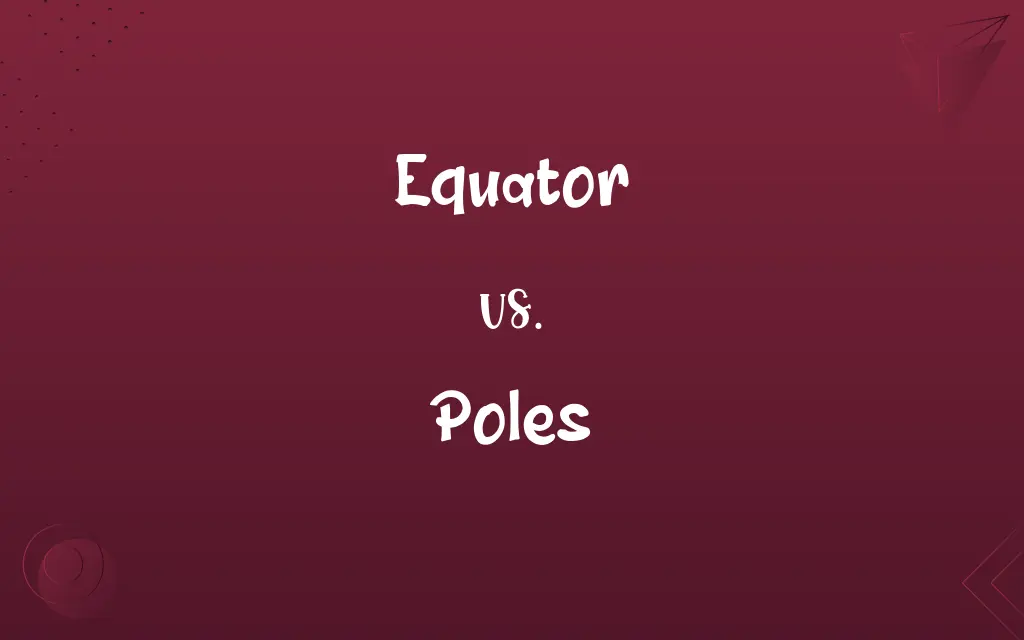Equator vs. Poles: Know the Difference

By Shumaila Saeed || Published on February 20, 2024
The Equator is Earth's imaginary line dividing the planet into northern and southern hemispheres, while the Poles are the northernmost and southernmost points where the Earth's axis intersects its surface.

Key Differences
The Equator, an imaginary line encircling the Earth, is equidistant from the North and South Poles. It divides the planet into the Northern and Southern Hemispheres. The Poles, located at Earth's extreme ends, are points of axial rotation and are defined as the North Pole and South Pole.
Shumaila Saeed
Feb 20, 2024
Climatically, the Equator experiences consistent, warm weather year-round due to direct sunlight. It's characterized by a tropical climate with little seasonal temperature variation. In contrast, the Poles are known for extreme cold, as they receive less direct sunlight, leading to frigid temperatures and polar climates.
Shumaila Saeed
Feb 20, 2024
Geographically, the Equator passes through multiple countries and oceans, demonstrating Earth's maximal circumference. The Poles, situated in polar regions, are points rather than lines, with the North Pole in the Arctic Ocean and the South Pole on the Antarctic continent.
Shumaila Saeed
Feb 20, 2024
The Equator is significant for navigation and climate studies, marking the midpoint between the poles. It's used to define latitude 0°. The Poles, representing Earth's rotational axis, are crucial in studies of Earth's magnetic field and are marked by latitudes 90°N and 90°S.
Shumaila Saeed
Feb 20, 2024
Day and night are of nearly equal duration year-round at the Equator. Conversely, the Poles experience extreme variations, with polar day (midnight sun) and polar night (sun does not rise) each lasting about six months.
Shumaila Saeed
Feb 20, 2024
ADVERTISEMENT
Comparison Chart
Geographical Feature
Imaginary line around Earth's widest part.
Northernmost and southernmost points of Earth.
Shumaila Saeed
Feb 20, 2024
Climate
Warm, tropical climate with little variation.
Extremely cold, polar climate with large variations.
Shumaila Saeed
Feb 20, 2024
Day/Night Duration
Nearly equal duration of day and night.
Extreme variations, with polar day and night.
Shumaila Saeed
Feb 20, 2024
Sunlight Exposure
Direct and consistent sunlight.
Limited, indirect sunlight with seasonal extremes.
Shumaila Saeed
Feb 20, 2024
ADVERTISEMENT
Equator and Poles Definitions
Equator
Earth's Midpoint Line
The Equator divides the Earth into two equal halves.
Shumaila Saeed
Jan 19, 2024
Poles
Earth's Extremes
The Poles are the most northerly and southerly points on Earth.
Shumaila Saeed
Jan 19, 2024
Equator
Climate Divider
Countries along the Equator experience warm climates.
Shumaila Saeed
Jan 19, 2024
Poles
Climate Extremes
The Poles are known for their extremely cold environments.
Shumaila Saeed
Jan 19, 2024
Equator
Navigation Reference
Sailors use the Equator as a key navigational reference.
Shumaila Saeed
Jan 19, 2024
ADVERTISEMENT
Poles
Magnetic Centers
The magnetic poles of Earth are often near the geographic Poles.
Shumaila Saeed
Jan 19, 2024
Equator
Equal Day and Night
At the Equator, day and night are almost the same length.
Shumaila Saeed
Jan 19, 2024
Poles
Either of the regions contiguous to the extremities of the earth's rotational axis, the North Pole or the South Pole.
Shumaila Saeed
Jan 18, 2024
Equator
The imaginary great circle around the earth's surface, equidistant from the poles and perpendicular to the earth's axis of rotation. It divides the earth into the Northern Hemisphere and the Southern Hemisphere.
Shumaila Saeed
Jan 18, 2024
Equator
A similar great circle drawn on the surface of a celestial body at right angles to the axis of rotation.
Shumaila Saeed
Jan 18, 2024
Poles
(Electricity) Either of two oppositely charged terminals, as in an electric cell or battery.
Shumaila Saeed
Jan 18, 2024
Equator
A circle that divides a sphere or other surface into congruent parts.
Shumaila Saeed
Jan 18, 2024
Equator
An imaginary great circle around Earth, equidistant from the two poles, and dividing earth's surface into the northern and southern hemisphere.
Shumaila Saeed
Jan 18, 2024
Equator
(astronomy) A similar great circle on any sphere, especially on a celestial body, or on other reasonably symmetrical three-dimensional body.
Shumaila Saeed
Jan 18, 2024
Equator
The midline of any generally spherical object, such as a fruit or vegetable, that has identifiable poles.
Slice the onion through the equator.
Shumaila Saeed
Jan 18, 2024
Poles
Either of two antithetical ideas, propensities, forces, or positions.
Shumaila Saeed
Jan 18, 2024
Equator
The imaginary great circle on the earth's surface, everywhere equally distant from the two poles, and dividing the earth's surface into two hemispheres.
Shumaila Saeed
Jan 18, 2024
Poles
The origin in a polar coordinate system; the vertex of a polar angle.
Shumaila Saeed
Jan 18, 2024
Equator
The great circle of the celestial sphere, coincident with the plane of the earth's equator; - so called because when the sun is in it, the days and nights are of equal length; hence called also the equinoctial, and on maps, globes, etc., the equinoctial line.
Shumaila Saeed
Jan 18, 2024
Poles
A point in the complex plane at which a given function is not defined.
Shumaila Saeed
Jan 18, 2024
Equator
An imaginary line around the Earth forming the great circle that is equidistant from the north and south poles;
The equator is the boundary between the northern and southern hemispheres
Shumaila Saeed
Jan 18, 2024
Poles
A long, relatively slender, generally rounded piece of wood or other material.
Shumaila Saeed
Jan 18, 2024
Equator
A circle dividing a sphere or other surface into two usually equal and symmetrical parts
Shumaila Saeed
Jan 18, 2024
Poles
The long tapering wooden shaft extending up from the front axle of a vehicle to the collars of the animals drawing it; a tongue.
Shumaila Saeed
Jan 18, 2024
Poles
(Sports) The inside position on the starting line of a racetrack
Qualified in the time trials to start on the pole.
Shumaila Saeed
Jan 18, 2024
Poles
To propel (oneself) or make (one's way) by the use of ski poles
"We ski through the glades on corn snow, then pole our way over a long one-hour runout to a road" (Frederick Selby).
Shumaila Saeed
Jan 18, 2024
Poles
Axis Points
Earth rotates around its axis, which intersects at the Poles.
Shumaila Saeed
Jan 19, 2024
Poles
Day/Night Phenomena
At the Poles, you can experience continuous daylight or darkness.
Shumaila Saeed
Jan 19, 2024
Repeatedly Asked Queries
How many countries does the Equator cross?
The Equator passes through 13 countries.
Shumaila Saeed
Feb 20, 2024
Does the Equator have constant weather?
Yes, the Equator has consistent, warm weather throughout the year.
Shumaila Saeed
Feb 20, 2024
Are the Poles always cold?
Yes, the Poles experience extremely cold temperatures year-round.
Shumaila Saeed
Feb 20, 2024
What is the Equator?
The Equator is an imaginary line encircling the Earth at equal distance from the Poles.
Shumaila Saeed
Feb 20, 2024
What's unique about the Poles' day and night?
The Poles have six months of continuous daylight and six months of darkness.
Shumaila Saeed
Feb 20, 2024
What are the Poles?
The Poles are the two points at the extreme ends of the Earth's axis.
Shumaila Saeed
Feb 20, 2024
Is there any land at the North Pole?
No, the North Pole is situated in the middle of the Arctic Ocean.
Shumaila Saeed
Feb 20, 2024
What happens at the Equinox at the Equator?
The Equinox at the Equator sees almost equal day and night.
Shumaila Saeed
Feb 20, 2024
What is the latitude of the Poles?
The North Pole is at 90°N and the South Pole at 90°S.
Shumaila Saeed
Feb 20, 2024
Do the Poles have seasons?
The Poles experience extreme seasonal variations in daylight but less in temperature.
Shumaila Saeed
Feb 20, 2024
Are the Poles important for Earth's climate?
Yes, the Poles significantly influence global climate patterns.
Shumaila Saeed
Feb 20, 2024
Do people live near the Equator?
Yes, many countries along the Equator are densely populated.
Shumaila Saeed
Feb 20, 2024
Is the South Pole on land?
Yes, the South Pole is located on the continent of Antarctica.
Shumaila Saeed
Feb 20, 2024
Does the Equator affect global winds?
Yes, the Equator plays a crucial role in the Earth's wind systems.
Shumaila Saeed
Feb 20, 2024
Can you visit the Poles?
Yes, but it requires specialized travel arrangements due to the extreme conditions.
Shumaila Saeed
Feb 20, 2024
Is the Equator the hottest part of Earth?
Not necessarily, but it is consistently warmer than other latitudes.
Shumaila Saeed
Feb 20, 2024
Can you see the Equator?
No, the Equator is an imaginary line and not visible.
Shumaila Saeed
Feb 20, 2024
Do the magnetic poles align with the geographic Poles?
The magnetic poles are close to but not exactly at the geographic Poles.
Shumaila Saeed
Feb 20, 2024
Is it dark all day in winter at the Poles?
Yes, during winter, the Poles experience continuous darkness.
Shumaila Saeed
Feb 20, 2024
Share this page
Link for your blog / website
HTML
Link to share via messenger
About Author
Written by
Shumaila SaeedShumaila Saeed, an expert content creator with 6 years of experience, specializes in distilling complex topics into easily digestible comparisons, shining a light on the nuances that both inform and educate readers with clarity and accuracy.









































































